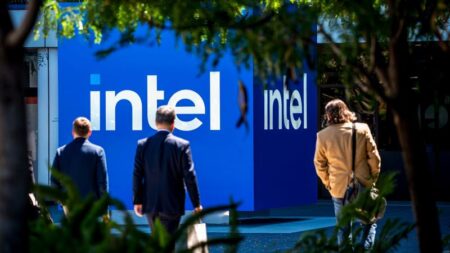The White House has officially confirmed ongoing discussions regarding a potential deal involving the acquisition of a 10% stake in the American semiconductor behemoth, Intel Corporation, by the federal government. This initiative, driven by the Trump administration, underscores a broader strategy to prioritize national interests, especially in terms of economic stability and security, according to White House Press Secretary Karoline Leavitt.
In recent conversations, Leavitt emphasized that this move is fundamental to meet America’s pressing needs in light of both national security and economic concerns. The potential agreement may take the form of an exchange where government grants are traded for Intel shares. This proposition was further elaborated upon by U.S. Commerce Secretary Howard Lutnick, who highlighted the need for a tangible return on investment from grants previously approved during the Biden administration.
Intel has faced formidable competition from tech titans such as Nvidia, Samsung, and TSMC—particularly in the rapidly expanding artificial intelligence (AI) chip sector. The insights shared by Lutnick indicate that the U.S. government seeks not just to provide financial assistance but aims to acquire equity stakes. The rationale behind this approach is to ensure that taxpayer money does not simply fund projects without yielding any ownership or return, effectively transforming grants into a strategic investment for the country.
As part of this potential agreement, the focus is on bolstering Intel’s manufacturing capabilities, notably in Ohio, where significant investment is anticipated to establish a state-of-the-art manufacturing hub. However, it’s crucial to note that several details of this arrangement remain speculative at this point. In earlier reports, a spokesperson for the White House had advised that any claims regarding the stake acquisition should be approached with caution unless formally announced.
In the wake of discussions surrounding the stake acquisition, Intel expressed its commitment to supporting initiatives aimed at strengthening domestic manufacturing and technological advancements in the U.S. Despite not directly addressing the negotiations, the company reiterated its proactive stance in working alongside the federal government to enhance the semiconductor landscape.
In an interesting turn of events, Japanese investment conglomerate SoftBank has announced its intent to acquire a $2 billion stake in Intel. This news has sparked positive market reactions, with Intel’s shares experiencing a nearly 7% surge on the New York Stock Exchange following the announcement. The investment by SoftBank is indicative of growing confidence in Intel’s capacity to reclaim its competitive edge within the semiconductor industry.
Generally, this potential deal between the Trump administration and Intel is emblematic of a broader trend where governments are increasingly engaging with technology companies to safeguard national interests and stimulate economic growth. The balance of power in the semiconductor sector is shifting, perhaps partly due to geopolitical factors, and this emerging partnership reflects an acknowledgment of the critical role these technologies play in the economy.
The broader implications of such a deal extend beyond mere financial investment; they potentially set a precedent for future interactions between government and private enterprise within critical industries. Stake acquisition by the government might redefine how public funds are applied—transitioning from mere grants to active participation in the ownership and direction of vital innovation sectors. As the discussion surrounding the 10% Intel stake continues, all eyes will be on how this initiative unfolds and what it means for the future of semiconductor manufacturing in the United States as it tries to recapture its market dominance.











